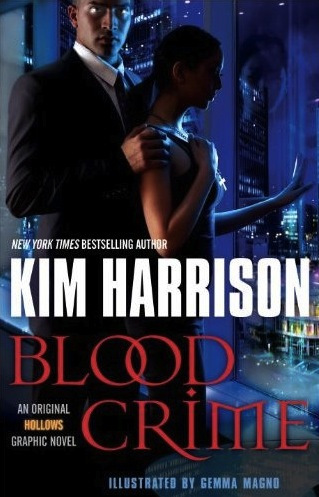Blood Crime, by Kim Harrison
Oct 22
2012

I have never read one of Kim Harrison's books, so when I received a copy of her upcoming graphic novel Blood Crime I had some background research to do. Thanks to Wikipedia, I now fully intend to hunt down the earlier installments in Harrison's "Hollows" urban fantasy series. How could I resist a story based on the premise that a significant portion of the human race died in the 1960s of a virus transmitted by genetically modified tomatoes, leading to a mass “coming out” of supernatural beings and a fear of tomato-based products? That's the kind of hardcore weirdness that fills my heart with joy.
While the novels and short stories in the Hollows series are told via the point of view of detective-witch Rachel Morgan, Blood Crime focuses on Rachel's partner, the “living vampire” Ivy Tamwood. Ivy will do anything to protect Rachel, but Ivy's vampire master Piscary has raised her (as he tried to do with her mother and grandmother) to be his soul mate, and he views Rachel's death as a helpful stepping stone on the road to Ivy's path to becoming his consort. So when Ivy and Rachel are hit by a series of increasingly bizarre attacks, Ivy has no idea which one of them is the target—they both have plenty of enemies, but she's desperately afraid that Piscary has decided Rachel's usefulness has come to an end.
The artwork in Blood Crime (by artist Gemma Magno and colorist Mae Hao) is solid, with flashes of excellence—the swirling, smoky shapes that indicate Ivy and Piscary's vampire shadows are particularly cool. The book comes with a few extras, including an “Artist's Sketchbook” section and some notes from the author, but none of these are particularly memorable. The most interesting thing about Blood Crime is its premise: Ivy's feelings for Rachel and Piscary are hopelessly tangled, and while Piscary is doing his best to manipulate the situation, Rachel has no idea the situation even exists.
Unfortunately, Blood Crime never develops this conflict to its full potential, at least not for a first-time reader of the series. It's possible that longtime fans of the books will find something meaningful about this installment, but if I hadn't read Kim Harrison's introductory note (which explains the nuances of Ivy's twisted relationships) the mixture of wordy exposition and over-the-top violence featured in Blood Crime would have made little impact. As it is, the idea is interesting, but the book packs about as much of an emotional wallop as Harrison's Wikipedia entry—maybe less, as at least the Wiki article made me curious about the rest of the series.
Review based on publisher-provided copy.
While the novels and short stories in the Hollows series are told via the point of view of detective-witch Rachel Morgan, Blood Crime focuses on Rachel's partner, the “living vampire” Ivy Tamwood. Ivy will do anything to protect Rachel, but Ivy's vampire master Piscary has raised her (as he tried to do with her mother and grandmother) to be his soul mate, and he views Rachel's death as a helpful stepping stone on the road to Ivy's path to becoming his consort. So when Ivy and Rachel are hit by a series of increasingly bizarre attacks, Ivy has no idea which one of them is the target—they both have plenty of enemies, but she's desperately afraid that Piscary has decided Rachel's usefulness has come to an end.
The artwork in Blood Crime (by artist Gemma Magno and colorist Mae Hao) is solid, with flashes of excellence—the swirling, smoky shapes that indicate Ivy and Piscary's vampire shadows are particularly cool. The book comes with a few extras, including an “Artist's Sketchbook” section and some notes from the author, but none of these are particularly memorable. The most interesting thing about Blood Crime is its premise: Ivy's feelings for Rachel and Piscary are hopelessly tangled, and while Piscary is doing his best to manipulate the situation, Rachel has no idea the situation even exists.
Unfortunately, Blood Crime never develops this conflict to its full potential, at least not for a first-time reader of the series. It's possible that longtime fans of the books will find something meaningful about this installment, but if I hadn't read Kim Harrison's introductory note (which explains the nuances of Ivy's twisted relationships) the mixture of wordy exposition and over-the-top violence featured in Blood Crime would have made little impact. As it is, the idea is interesting, but the book packs about as much of an emotional wallop as Harrison's Wikipedia entry—maybe less, as at least the Wiki article made me curious about the rest of the series.
Review based on publisher-provided copy.
Posted by: Julianka
No new comments are allowed on this post.
Comments
No comments yet. Be the first!